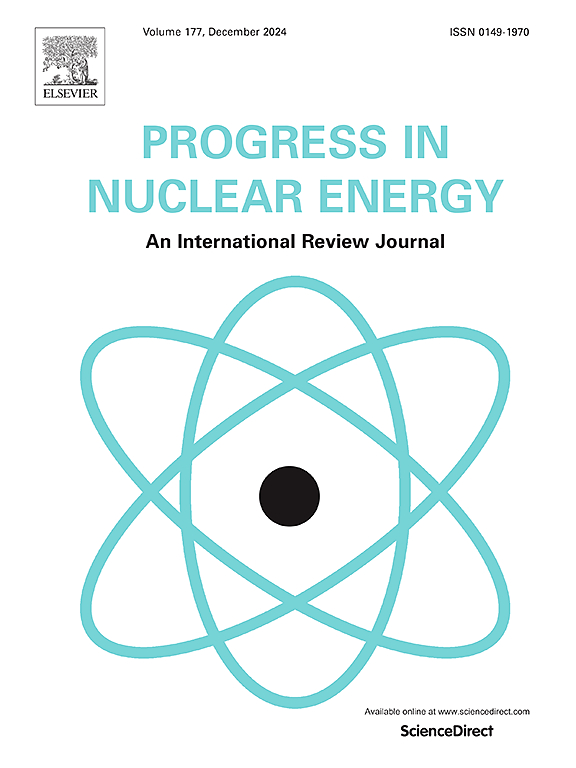Analysis of electroneutrality of fission products in molten salt reactors
IF 3.3
3区 工程技术
Q1 NUCLEAR SCIENCE & TECHNOLOGY
引用次数: 0
Abstract
Liquid-fuel molten salt reactors are a type of Generation IV reactors that has attracted attention for their enhanced safety and thermal efficiency. However, the liquid state of the fuel introduces complexity to the reactor system, particularly in relation to the behavior of fission products and the challenge of maintaining electroneutrality. The interaction of the liquid fuel and the container material, along with the release of noble gas fission products, complicates the analysis of electroneutrality. This study examines the electroneutrality of fission products from key fissile isotopes that could be utilized in molten salt reactors. The calculations take into account variables such as the type of salt (chlorides or fluorides), fissile isotope (Th, U, or Pu), and neutron energy (thermal or fast). Three scenarios involving noble gas release are compared to assess its impact on electroneutrality. Fission of Th-232, U-233, and U-235 can mitigate oxidizing conditions post-fission, by controlling the initial valence state of the fissile isotopes. In contrast, the fission of U-238 and Pu isotopes consistently results in an oxidizing environment. These findings indicate that molten salt reactors relying solely on U-238 and Pu may experience oxidizing conditions due to the fission reaction, suggesting that additional measures may be necessary to prevent excessive oxidation of the reactor system.
熔盐反应堆裂变产物的电中性分析
液体燃料熔盐反应堆是第四代反应堆的一种,因其更高的安全性和热效率而备受关注。然而,燃料的液态给反应堆系统带来了复杂性,特别是裂变产物的行为和保持电中性的挑战。液体燃料与容器材料的相互作用,以及惰性气体裂变产物的释放,使电中性分析变得更加复杂。本研究探讨了可用于熔盐反应堆的主要裂变同位素的裂变产物的电中性。计算中考虑了盐的类型(氯化物或氟化物)、裂变同位素(钍、铀或钚)和中子能量(热能或快能)等变量。对涉及惰性气体释放的三种情况进行了比较,以评估其对电中性的影响。钍-232、铀-233 和铀-235 的裂变可以通过控制易裂变同位素的初始价态来缓解裂变后的氧化条件。相比之下,铀 238 和钚同位素的裂变始终会导致氧化环境。这些研究结果表明,仅依靠铀 238 和钚的熔盐反应堆可能会因裂变反应而出现氧化条件,这表明可能需要采取额外措施来防止反应堆系统过度氧化。
本文章由计算机程序翻译,如有差异,请以英文原文为准。
求助全文
约1分钟内获得全文
求助全文
来源期刊

Progress in Nuclear Energy
工程技术-核科学技术
CiteScore
5.30
自引率
14.80%
发文量
331
审稿时长
3.5 months
期刊介绍:
Progress in Nuclear Energy is an international review journal covering all aspects of nuclear science and engineering. In keeping with the maturity of nuclear power, articles on safety, siting and environmental problems are encouraged, as are those associated with economics and fuel management. However, basic physics and engineering will remain an important aspect of the editorial policy. Articles published are either of a review nature or present new material in more depth. They are aimed at researchers and technically-oriented managers working in the nuclear energy field.
Please note the following:
1) PNE seeks high quality research papers which are medium to long in length. Short research papers should be submitted to the journal Annals in Nuclear Energy.
2) PNE reserves the right to reject papers which are based solely on routine application of computer codes used to produce reactor designs or explain existing reactor phenomena. Such papers, although worthy, are best left as laboratory reports whereas Progress in Nuclear Energy seeks papers of originality, which are archival in nature, in the fields of mathematical and experimental nuclear technology, including fission, fusion (blanket physics, radiation damage), safety, materials aspects, economics, etc.
3) Review papers, which may occasionally be invited, are particularly sought by the journal in these fields.
 求助内容:
求助内容: 应助结果提醒方式:
应助结果提醒方式:


